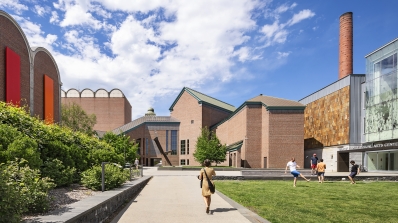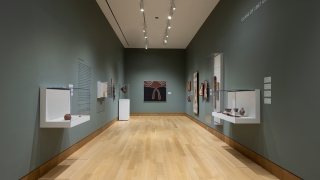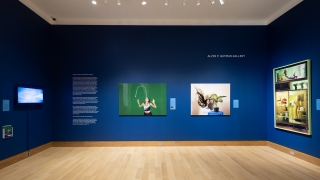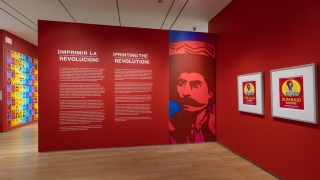Exhibitions Archive
Ga Bose Gangwe
Mohau ModisakengThe works of Mika Rottenberg and Luis Gispert use a heightened sense of reality to explore ideas of class, gender, and identity. Surrealist at times, their photography and video installations are both filled with exuberant iconography and highly choreographed––every element is carefully orchestrated, from the extravagant outfits to the upscale mise-en-scène and the subjects’ aggressive and theatrical gestures. Their works draw from Social Surrealism, a movement which borrows from European surrealist techniques of the 1920s and 30s to provide social commentary and criticism. The surrealist art movement of the early twentieth century challenged the status-quo and explored new understandings of the unconscious. The rise of revolutionary thinking and liberation of the mind and artistic expression also turned to social and political activism. Rottenberg and Gispert explore similar ideas through the lens of the Latinx experience of contemporary capitalism.
A Space for Dialogue is a student-curated exhibition program that began in 2001. Hood Museum of Art interns create an installation drawn from the museum's permanent collection by engaging with every aspect of curation, from doing research and selecting objects, to choosing frames and a wall color, to planning a layout and writing labels and a brochure, to giving a public talk. There have been over 100 A Space for Dialogue exhibitions on a wide variety of themes.
In the 1960s, activist Chicano artists forged a remarkable history of printmaking that remains vital today. Many artists came of age during the civil rights, labor, anti-war, feminist and LGBTQ+ movements and channeled the period’s social activism into assertive aesthetic statements that announced a new political and cultural consciousness among people of Mexican descent in the United States. ¡Printing the Revolution! explores the rise of Chicano graphics within these early social movements and the ways in which Chicanx artists since then have advanced innovative printmaking practices attuned to social justice.
More than reflecting the need for social change, the works in this exhibition project and revise notions of Chicanx identity, spur political activism and school viewers in new understandings of U.S. and international history. By employing diverse visual and artistic modes from satire, to portraiture, appropriation, conceptualism, and politicized pop, the artists in this exhibition build an enduring and inventive graphic tradition that has yet to be fully integrated into the history of U.S. printmaking.
Ink Reimagined
Park Dae SungInk Reimagined is a groundbreaking solo exhibition of contemporary Korean ink painter Park Dae Sung’s works. Park, who lost an arm during the tumultuous pre-Korean War period, is a self-taught artist who saw nature as his teacher and thus traveled widely, finding inspiration in China, Taiwan, New York City, and the mountains of North Korea. Featuring paintings of enormous scale and refined technique, Park’s ongoing contemplation of ancient landscapes and objects asks the viewer to rethink modernity via tradition and gain a fresh appreciation for the diversity of styles—from dramatic to meditative to bursting with movement—possible through ink and brush. Due to popular demand, two of the three galleries in the exhibition will remain on view through May 20!
Forming Body and Identity
Taking Up SpaceThe formation of identity is a continuous and fluid reshaping of the self. Through the works of various contemporary American artists, Taking Up Space explores the physical and emotional relationships they have with their bodies, and the ways in which public expression of identity shapes lived experience.
A Space for Dialogue is a student-curated exhibition program that began in 2001. Hood Museum of Art interns create an installation drawn from the museum's permanent collection by engaging with every aspect of curation, from doing research and selecting objects, to choosing frames and a wall color, to planning a layout and writing labels and a brochure, to giving a public talk. There have been over 100 A Space for Dialogue exhibitions on a wide variety of themes.






![Daniel A. Heyman, Untitled [Vincent], from the Tattoo Series, 2002, chine collé etching on cotton paper. Hood Museum of Art, Dartmouth; Gift of Vincent Renou; 2005.32.7. © Daniel A. Heyman A work on paper of a reclining male nude. The color palette is mostly warm browns and the figure of the reclining nude male's skin looks marbled.](https://hoodmuseum.dartmouth.edu/sites/hoodmuseum.prod/files/styles/max_320/public/hoodmuseum/images/exhibition_images/inside_left_daniel_heyman.jpg?itok=MWAHjabE)